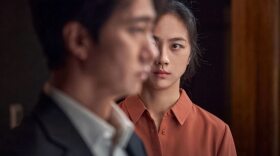As an undergraduate student at Rice University, Rebecca Shewmaker remembers walking through museums with her professors and feeling inspired by what she saw. Now, she has the opportunity to work with and inspire a new generation of makers as one of four community artists selected by the Amon Carter Museum of American Art.
The partnership between the museum and local artists started in 2018 as a way to engage and support local artists by giving them the opportunity to collaborate on exhibits, events and community outreach.
“I really want to give back,” she said. “It’s a great way for artists to help connect the community to artworks and to the museum.”
From a distance, Shewmaker’s work looks like an oil painting of a landscape, but, up close, it becomes clear that she uses thread to “paint” the scenery.
The technique is unique, and Shewmaker is looking forward to sharing her process with a broader audience.
“I’ll bring new techniques and ideas to a group of people and then see them add their own creativity to it. It’s really interesting and a lot of fun because it opens up new ideas for me,” she said. “I find that teaching, whether it be a workshop or a class, always forces me to do my best and (there’s) always something I can take away from that and bring back into the studio.”
Fellow Carter Community Artist, Adam Fung, is also looking forward to the opportunity to both learn and teach at the museum.
“I was really attracted to being involved with the institution as a whole, but also as a way for me to connect with different communities of people and the place that I live,” he said. “As an artist, I’m always engaged with painting, but I want to do other things, too, just to open up those pathways in the brain.”
Every semester, the oil painter and associate professor in Texas Christian University’s College of Fine Arts, encourages his students to create a painting that is not the shape of a square or rectangle. Challenging this default way of thinking, which he says is reinforced by our phones, is a principle that he tries to practice himself.
Fung is excited by the idea of bringing art into unexpected places. He has experimented with creating inflatable art before and said the medium is ripe for collaboration.
“It’s not something I’m good at, so it allows me to connect with students, or, in the case of the Carter, different audiences where we’re learning together and problem solving.”
Likewise, Kathy Brown, is planning to bring new ideas and forms to the program.
“I’m most excited about the possibilities and working with diverse people and maybe opening up the ideas of what art can be or what community outreach can be,” she said. “I think that it can plant the seeds of something that can grow into different relationships and additional opportunities to make work, to do things collaboratively and to show your work. The possibilities are endless.”
Brown is an assistant professor at the University of North Texas’ College of Visual Arts and Design, and was encouraged to apply to the Carter Community Artist program by her colleague and alumna of the program, Lauren Cross.
Her work leans into juxtaposition, creating sculptures with fabric and using soft material as a way to discuss hard topics.
One of her pieces features a plethora of hand-sewn fabrics that cascade into a bust of a woman wearing a scarf tied around her head.
“That came out of the summer of 2020. And it was a reaction to the state that we were in and the idea of “artivism,” or protest art, and making a statement about what was happening with Breonna Taylor, Sandra Bland before that, and many, many years prior Sergeant Isaac Woodard … it was a way to respond to what was happening around us,” she said.
Having her artistic value affirmed by the Carter and being selected as a community artist was heartening for Olivia Garcia-Hassell.
“I feel like an outsider a lot of the time. I don’t always quite know where I fit in,” she said. “I mean, I’m half Cuban and half Caucasian, and I’m gay. Teaching was hard because I couldn’t fully be myself, and it was really validating (to be selected).”
Garcia-Hassell dabbles in several different forms, from drawing to painting to renovating and photographing dollhouses, but her art tends to reflect a common theme: the human condition.
“The dollhouse interiors are a way to capture a dreamlike (space) sort of outside reality. It’s a real photograph, of the real thing. But you can tell that it’s been manipulated and painted and changed and it’s not quite right,” she said. “I would say that my work is more about the parts of life that don’t feel quite right or an exploration of … universal emotions people feel.”
As a former teacher, Garcia-Hassell is looking forward to engaging middle school or new high school students and introducing them to the plethora of opportunities and art forms that exist. She also would like to work on drawing more Spanish speakers into the museum.
“A lot of my students would tell me that they’d never been to the museums because of transportation or money or because they felt like they didn’t fit in,” she said. “For me, (it’s important) to connect to the community in that way (and show) museums aren’t just for the fancily dressed upper echelon of society. It’s for everyone … And you don’t have to be a certain way to come to the museum.”
Marcheta Fornoff covers the arts for the Fort Worth Report. Contact her at marcheta.fornoff@fortworthreport.org or on Twitter. At the Fort Worth Report, news decisions are made independently of our board members and financial supporters. Read more about our editorial independence policy here.




